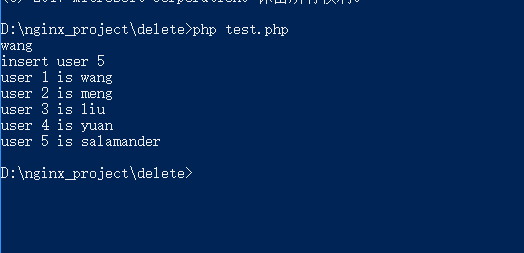жВ®е•љпЉМзЩїељХеРОжЙНиГљдЄЛиЃҐеНХеУ¶пЉБ
жВ®е•љпЉМзЩїељХеРОжЙНиГљдЄЛиЃҐеНХеУ¶пЉБ
е∞ПзЉЦзїЩе§ІеЃґеИЖдЇЂдЄАдЄЛPHPдљњзФ®PDOе∞Би£ЕDBз±їзЪДж°ИдЊЛпЉМзЫЄдњ°е§ІйГ®еИЖдЇЇйГљињШдЄНжАОдєИдЇЖиІ£пЉМеЫ†ж≠§еИЖдЇЂињЩзѓЗжЦЗзЂ†зїЩе§ІеЃґеПВиАГдЄАдЄЛпЉМеЄМжЬЫе§ІеЃґйШЕиѓїеЃМињЩзѓЗжЦЗзЂ†еРОе§ІжЬЙжФґиОЈпЉМдЄЛйЭҐиЃ©жИСдїђдЄАиµЈеОїдЇЖиІ£дЄАдЄЛеРІпЉБ
PHPе¶ВдљХеИ©зФ®PDOе∞Би£ЕзЃАеНХжШУзФ®зЪДDBз±ї
дљњзФ®
еИЫеїЇжµЛиѓХеЇУеТМи°®
create database db_test; CREATE TABLE `user` ( `id` int(10) unsigned NOT NULL AUTO_INCREMENT, `name` char(11) NOT NULL, `created_at` int(10) unsigned NOT NULL, PRIMARY KEY (`uid`) ) ENGINE=InnoDB DEFAULT CHARSET=utf8; INSERT INTO `user` VALUES ('1', 'wang', '1501109027'); INSERT INTO `user` VALUES ('2', 'meng', '1501109026'); INSERT INTO `user` VALUES ('3', 'liu', '1501009027'); INSERT INTO `user` VALUES ('4', 'yuan', '1500109027');дї£з†БжµЛиѓХ
require __DIR__ . '/DB.php'; $db = new DB(); $db->__setup([ 'dsn'=>'mysql:dbname=db_test;host=localhost', 'username'=>'root', 'password'=>'******', 'charset'=>'utf8' ]); $user = $db->fetch('SELECT * FROM user where id = :id', ['id' => 1]); echo $user['name']; echo "\n"; $insertId = $db->insert('user', ['name' => 'salamander', 'created_at' => time()]); echo "insert user {$insertId}\n"; $users = $db->fetchAll('SELECT * FROM user'); foreach ($users as $item) { echo "user {$item['id']} is {$item['name']} \n"; }
ињРи°МзїУжЮЬ

DBеЈ•еЕЈз±ї
<?php /** * User: Salamander * Date: 2016/9/2 * Time: 9:16 */ class DB { private $dsn; private $sth; private $dbh; private $user; private $charset; private $password; public $lastSQL = ''; public function __setup($config = array()) { $this->dsn = $config['dsn']; $this->user = $config['username']; $this->password = $config['password']; $this->charset = $config['charset']; $this->connect(); } private function connect() { if(!$this->dbh){ $options = array( \PDO::MYSQL_ATTR_INIT_COMMAND => 'SET NAMES ' . $this->charset, ); $this->dbh = new \PDO($this->dsn, $this->user, $this->password, $options); } } public function beginTransaction() { return $this->dbh->beginTransaction(); } public function inTransaction() { return $this->dbh->inTransaction(); } public function rollBack() { return $this->dbh->rollBack(); } public function commit() { return $this->dbh->commit(); } function watchException($execute_state) { if(!$execute_state){ throw new MySQLException("SQL: {$this->lastSQL}\n".$this->sth->errorInfo()[2], intval($this->sth->errorCode())); } } public function fetchAll($sql, $parameters=[]) { $result = []; $this->lastSQL = $sql; $this->sth = $this->dbh->prepare($sql); $this->watchException($this->sth->execute($parameters)); while($result[] = $this->sth->fetch(\PDO::FETCH_ASSOC)){ } array_pop($result); return $result; } public function fetchColumnAll($sql, $parameters=[], $position=0) { $result = []; $this->lastSQL = $sql; $this->sth = $this->dbh->prepare($sql); $this->watchException($this->sth->execute($parameters)); while($result[] = $this->sth->fetch(\PDO::FETCH_COLUMN, $position)){ } array_pop($result); return $result; } public function exists($sql, $parameters=[]) { $this->lastSQL = $sql; $data = $this->fetch($sql, $parameters); return !empty($data); } public function query($sql, $parameters=[]) { $this->lastSQL = $sql; $this->sth = $this->dbh->prepare($sql); $this->watchException($this->sth->execute($parameters)); return $this->sth->rowCount(); } public function fetch($sql, $parameters=[], $type=\PDO::FETCH_ASSOC) { $this->lastSQL = $sql; $this->sth = $this->dbh->prepare($sql); $this->watchException($this->sth->execute($parameters)); return $this->sth->fetch($type); } public function fetchColumn($sql, $parameters=[], $position=0) { $this->lastSQL = $sql; $this->sth = $this->dbh->prepare($sql); $this->watchException($this->sth->execute($parameters)); return $this->sth->fetch(\PDO::FETCH_COLUMN, $position); } public function update($table, $parameters=[], $condition=[]) { $table = $this->format_table_name($table); $sql = "UPDATE $table SET "; $fields = []; $pdo_parameters = []; foreach ( $parameters as $field=>$value){ $fields[] = '`'.$field.'`=:field_'.$field; $pdo_parameters['field_'.$field] = $value; } $sql .= implode(',', $fields); $fields = []; $where = ''; if(is_string($condition)) { $where = $condition; } else if(is_array($condition)) { foreach($condition as $field=>$value){ $parameters[$field] = $value; $fields[] = '`'.$field.'`=:condition_'.$field; $pdo_parameters['condition_'.$field] = $value; } $where = implode(' AND ', $fields); } if(!empty($where)) { $sql .= ' WHERE '.$where; } return $this->query($sql, $pdo_parameters); } public function insert($table, $parameters=[]) { $table = $this->format_table_name($table); $sql = "INSERT INTO $table"; $fields = []; $placeholder = []; foreach ( $parameters as $field=>$value){ $placeholder[] = ':'.$field; $fields[] = '`'.$field.'`'; } $sql .= '('.implode(",", $fields).') VALUES ('.implode(",", $placeholder).')'; $this->lastSQL = $sql; $this->sth = $this->dbh->prepare($sql); $this->watchException($this->sth->execute($parameters)); $id = $this->dbh->lastInsertId(); if(empty($id)) { return $this->sth->rowCount(); } else { return $id; } } public function errorInfo() { return $this->sth->errorInfo(); } protected function format_table_name($table) { $parts = explode(".", $table, 2); if(count($parts) > 1) { $table = $parts[0].".`{$parts[1]}`"; } else { $table = "`$table`"; } return $table; } function errorCode() { return $this->sth->errorCode(); } } class MySQLException extends \Exception { }ж°ЖжЮґдЄ≠дљњзФ®еїЇиЃЃ
еЬ®ж°ЖжЮґдЄ≠дљњзФ®DBз±ї,зФ®еНХдЊЛж®°еЉПжИЦиАЕзФ®дЊЭиµЦеЃєеЩ®жЭ•зЃ°зРЖиЊГе•љгАВ
дї•дЄКжШѓвАЬPHPдљњзФ®PDOе∞Би£ЕDBз±їзЪДж°ИдЊЛвАЭињЩзѓЗжЦЗзЂ†зЪДжЙАжЬЙеЖЕеЃєпЉМжДЯи∞ҐеРДдљНзЪДйШЕиѓїпЉБзЫЄдњ°е§ІеЃґйГљжЬЙдЇЖдЄАеЃЪзЪДдЇЖиІ£пЉМеЄМжЬЫеИЖдЇЂзЪДеЖЕеЃєеѓєе§ІеЃґжЬЙжЙАеЄЃеК©пЉМе¶ВжЮЬињШжГ≥е≠¶дє†жЫіе§ЪзЯ•иѓЖпЉМ搥ињОеЕ≥ж≥®дЇњйАЯдЇСи°МдЄЪиµДиЃѓйҐСйБУпЉБ
еЕНиі£е£∞жШОпЉЪжЬђзЂЩеПСеЄГзЪДеЖЕеЃєпЉИеЫЊзЙЗгАБиІЖйҐСеТМжЦЗе≠ЧпЉЙдї•еОЯеИЫгАБиљђиљљеТМеИЖдЇЂдЄЇдЄїпЉМжЦЗзЂ†иІВзВєдЄНдї£и°®жЬђзљСзЂЩзЂЛеЬЇпЉМе¶ВжЮЬжґЙеПКдЊµжЭГиѓЈиБФз≥їзЂЩйХњйВЃзЃ±пЉЪis@yisu.comињЫи°МдЄЊжК•пЉМеєґжПРдЊЫзЫЄеЕ≥иѓБжНЃпЉМдЄАзїПжЯ•еЃЮпЉМе∞ЖзЂЛеИїеИ†йЩ§жґЙеЂМдЊµжЭГеЖЕеЃєгАВ